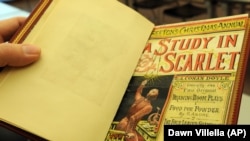The scene is very troubling.
White lines mark the place on the floor where a person has fallen -- dead. There is blood covering the floor. There is blood on the walls.
Police officers and a detective examine evidence in the apartment: a broken window, a bloody glove and knife, dozens of photographs thrown onto the floor.
If you had to guess what this scene is, you might say it is a terrible crime scene.
But actually, it could be a lesson in an English class.
Some English teachers around the world are using nontraditional materials – such as murder mysteries – to keep their students interested. And it’s not just teachers. Organizations like the British Council are also using murder mysteries to teach English.
As a lesson plan, a murder mystery offers basic questions for students to answer: Who is the victim? Who is the suspect? How did the murderer kill the person and with what weapon? Where did the murder happen: What is the setting? Why did the murder happen: What is the motive?
Murder mysteries also give a chance for role-playing, a technique long used in the language learning classroom. Students can take turns playing the detective, the witnesses and the suspects.
Teachers who use murder mysteries in the classroom have another reason – they are fun. There is something appealing about mysteries and solving a crime.
Students may agree. The book company Scholastic recently asked children what kinds of books they like to read most. Mysteries were at the top of the list.
This is hardly a surprise.
Many children in the U.S. grow up reading mysteries of Nancy Drew and the Hardy Boys. The murder mystery board game Clue -- where players need to find who killed whom, with what weapon and where -- has been popular in the U.S. since the 1950s.
And the character Sherlock Holmes created by Sir Arthur Conan Doyle has been popular in its many versions for decades.
So, many people like mysteries. And teachers are using that to help them in the classroom.
Recently, The Atlantic magazine published a story on a teacher using murder mysteries to teach her class.
Jeni Peake teaches English for the Cambridge School in Lisbon, Portugal. She began using murder mysteries to make teaching and learning grammar more fun.
Jeni Peake says her students use the murder mystery to interview each other. They are looking for answers to those important questions we talked about earlier: who, what, where, when, why and how. They also must use different verb tenses to describe the events to the “detective.” And when describing the weapon, setting and motive, students must find the right vocabulary.
In The Atlantic article, one of Peake’s students says role-playing and having a clear goal of finding the murderer keeps the students focused.
But is using murder to teach appropriate? Some critics say no.
Janet Isserlis is an expert of teaching English as a Second Language at the Rhode Island Adult Education Professional Development Center. For several decades, she has taught refugees from many countries around the world.
Isserlis says that for many people -- but particularly many English language learners -- the idea or notion of making fun of murder may be distressing.
“Particularly with English language learners (ELL), so many ELLs come from countries where people have experienced violence caused by political upheaval and war. And so, the notion making fun and enjoying a murder mystery may not be enjoyable for those people.”
Isserlis says that language and language learning is innately, or naturally, a social process. People come together and often share personal details. She says she learned early in her career to avoid questions that brought up painful memories. Instead, she focused on the present and asked questions that were in the students’ comfort zones.
“I think, until you get to know who the learners are, you want to avoid questions about home life, about family, certainly about war and about violence. Language is innately a social process and language learning is certainly social. As people come together and know about each other, they will start to share what they’re comfortable sharing...”
Teacher Jeni Peake says that murder mysteries offer great chances for role-playing as well as question-and-answer activities. Isserlis says murder mysteries may provide rich details and complicated scenarios. But she adds, there are other, less violent, choices available. Everyday life, she says, can provide enough material for teachers to use.
“Some of those murder mysteries provide very detailed and rich and complicated scenarios. But I think there are other ways to look at complicated and rich things that happen every day either through people watching, talking about who you see on the bus, or any number of things such as that.”
Janet Isserlis adds that even if a student is an adult and has not experienced war or violence, they may find the topic of murder upsetting. Jeni Peake says her students enjoy using murder mysteries in the classroom.
What do you think? Should murder mysteries be used to teach English in a classroom?
Let us know in the Comments Section or join our conversation about this topic on Facebook.
I’m Anna Matteo.
Anna Matteo wrote this story for VOA Learning English. Kathleen Struck was the editor.
______________________________________________________________
Words in This Story
setting – n. the place and conditions in which something happens or exists
motive – n. a reason for doing something
role-playing – n. an activity in which people do and say things while pretending to be someone else or while pretending to be in a particular situation
detective – n. a police officer whose job is to find information about crimes that have occurred and to catch criminals
appropriate – adj. right or suited for some purpose or situation
notion – n. an idea or opinion
innately – adj. existing from the time a person or animal is born
comfort zone – n. a place, situation, or level where someone feels confident and comfortable
comfortable – adj. not causing any physically unpleasant feelings : producing physical comfort
complicated – adj. having many parts or steps
scenario – n. a description of what could possibly happen







